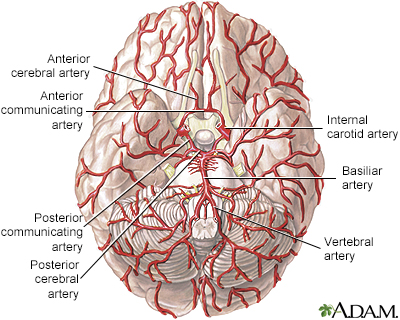Vertebrobasilar circulatory disorders
Vertebrobasilar insufficiency; Posterior circulation ischemia; Beauty parlor syndrome; TIA - vertebrobasilar insufficiency; Dizziness - vertebrobasilar insufficiency; Vertigo - vertebrobasilar insufficiency
Vertebrobasilar circulatory disorders are conditions in which the blood supply to the back of the brain is disrupted.

The internal carotid arteries and the vertebral arteries supply blood to the brain.
Causes
In the neck, two vertebral arteries join to form the basilar artery, which enters the skull. These are the main blood vessels that provide blood flow to the back of the brain.
The areas in the back of the brain that receive blood from these arteries are needed to keep a person alive. These areas regulate breathing, heart rate, swallowing, vision, movement, and posture or balance. All of the nervous system signals that connect the brain to the rest of the body pass through the back of the brain.
Many different conditions may reduce or stop blood flow in the back part of the brain. The most common risk factors are smoking, high blood pressure, diabetes, increased age, and a high cholesterol level. These are similar to the risk factors for any stroke.
Other causes include:
- Tear in the wall of an artery
- Blood clots in the heart that travel to the vertebral or basilar arteries and cause a stroke
- Blood vessel inflammation (vasculitis)
- Connective tissue diseases
- Problems in the spinal bones of the neck
- Outside pressure on the vertebral or basilar arteries, such as from a salon sink (nicknamed beauty parlor syndrome)
Symptoms
Common symptoms may include:
- Difficulty pronouncing words, slurred speech
- Difficulty swallowing
- Double vision or vision loss
- Numbness or tingling, most often on the face or scalp
- Sudden falls (drop attacks)
- Vertigo (sensation of things spinning around)
- Memory loss
Other symptoms may include:
- Bladder or bowel control problems
- Difficulty walking (unsteady gait)
- Headache, neck ache
- Hearing loss
- Muscle weakness
- Nausea and vomiting
- Pain in one or more parts of the body, which gets worse with touch and cold temperatures
- Poor coordination
- Sleepiness or sleep from which the person cannot be awakened
- Sudden, uncoordinated movements
- Sweating on the face, arms, or legs
Exams and Tests
You may have the following tests, depending on the cause:
- CT or MRI of the brain
- Computed tomography angiography (CTA), magnetic resonance angiography (MRA), or ultrasound to look at blood vessels in the brain
- Blood tests, including blood clotting studies
- Echocardiogram
- Electrocardiogram (ECG) and Holter monitor (24-hour ECG)
- X-rays of the arteries (angiogram)
Treatment
Vertebral or basilar symptoms that start suddenly are a medical emergency that need to be treated right away. Treatment is similar to that for stroke. Depending on how long you have had symptoms among others, a medicine may be infused to break open any blood clots. A catheter may be inserted into a blood vessel to remove a clot. Some people receive both treatments.
To prevent the condition, your health care provider may recommend:
- Taking blood-thinning medicines, such as aspirin, novel oral anticoagulants (such as apixaban, rivaroxaban, or others) or clopidogrel (Plavix) to lower the risk for stroke
- Changing your diet
- Medicine to lower cholesterol and better regulate blood pressure
- Exercising
- Losing weight
- Stopping smoking
Invasive procedures or surgery of narrowed arteries for stroke prevention in this part of the brain are not well studied or proven.
Outlook (Prognosis)
The outlook depends on:
- The amount of brain damage
- What body functions have been affected
- How quickly you get treatment
- How quickly you recover
Each person has a different recovery time and need for long-term care. Problems with moving, thinking, and talking often improve in the first weeks or months. Some people will keep improving for months or years.
Possible Complications
Complications of vertebrobasilar circulatory disorders are the same as for a stroke. These include:
- Breathing (respiratory) failure (which may require the use of a machine to help the person breathe)
- Lung problems (especially lung infections)
- Heart attack
- Lack of fluids in the body (dehydration) and swallowing problems (sometimes requiring tube feeding)
- Problems with movement or sensation, including paralysis and numbness
- Formation of blood clots in the legs
- Vision loss
Complications caused by medicines or surgery may also occur.
When to Contact a Medical Professional
Call 911 or the local emergency number, or get to the emergency room if you have any symptoms of a vertebral or basilar circulatory disorder.
References
Crane BT, Kaylie DM. Central vestibular disorders. In: Flint PW, Francis HW, Haughey BH, et al, eds. Cummings Otolaryngology: Head and Neck Surgery. 7th ed. Philadelphia, PA: Elsevier; 2021:chap 168.
Jovin TG, Li C, Wu L, et al. Trial of thrombectomy 6 to 24 Hours after stroke due to basilar-artery occlusion. N Engl J Med. 2022;387(15):1373-1384. PMID: 36239645
Kleindorfer DO, Towfighi A, Chaturvedi S, et al. 2021 Guideline for the prevention of stroke in patients with stroke and transient ischemic attack: a guideline from the American Heart Association/American Stroke Association. Stroke. 2021;52(7):e364-e467. PMID: 34024117
Kim JS, Caplan LR. Vertebrobasilar disease. In: Grotta JC, Albers GW, Broderick JP, et al, eds. Stroke: Pathophysiology, Diagnosis, and Management. 7th ed. Philadelphia, PA: Elsevier; 2022:chap 26.
Version Info
Last reviewed on: 8/19/2024
Reviewed by: Joseph V. Campellone, MD, Department of Neurology, Cooper Medical School at Rowan University, Camden, NJ. Review provided by VeriMed Healthcare Network. Also reviewed by David C. Dugdale, MD, Medical Director, Brenda Conaway, Editorial Director, and the A.D.A.M. Editorial team.
